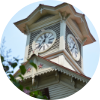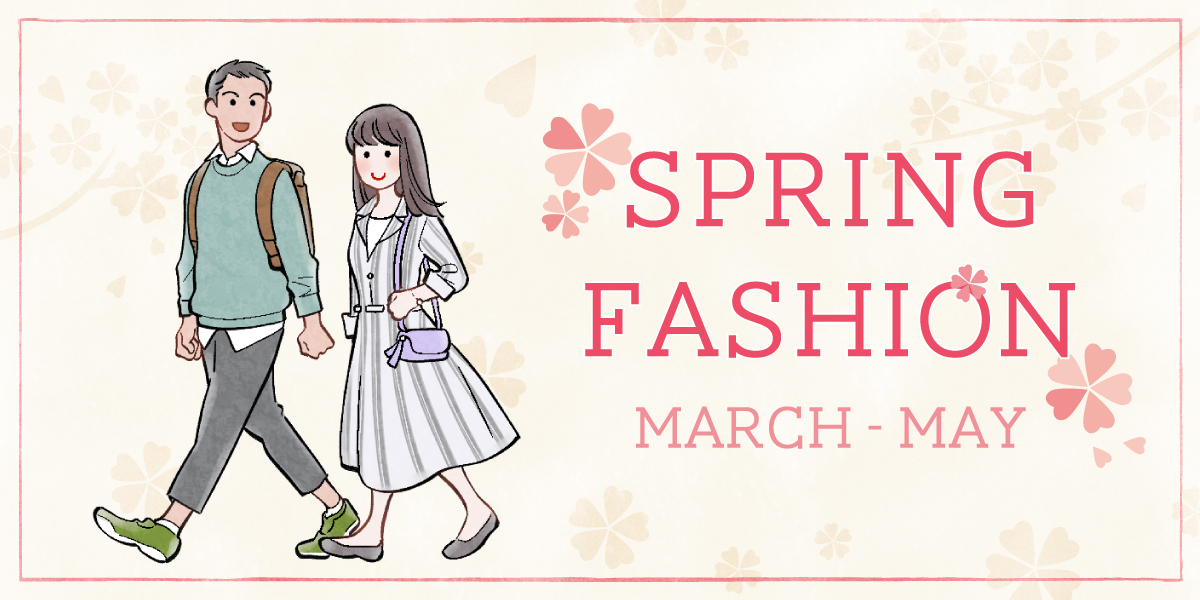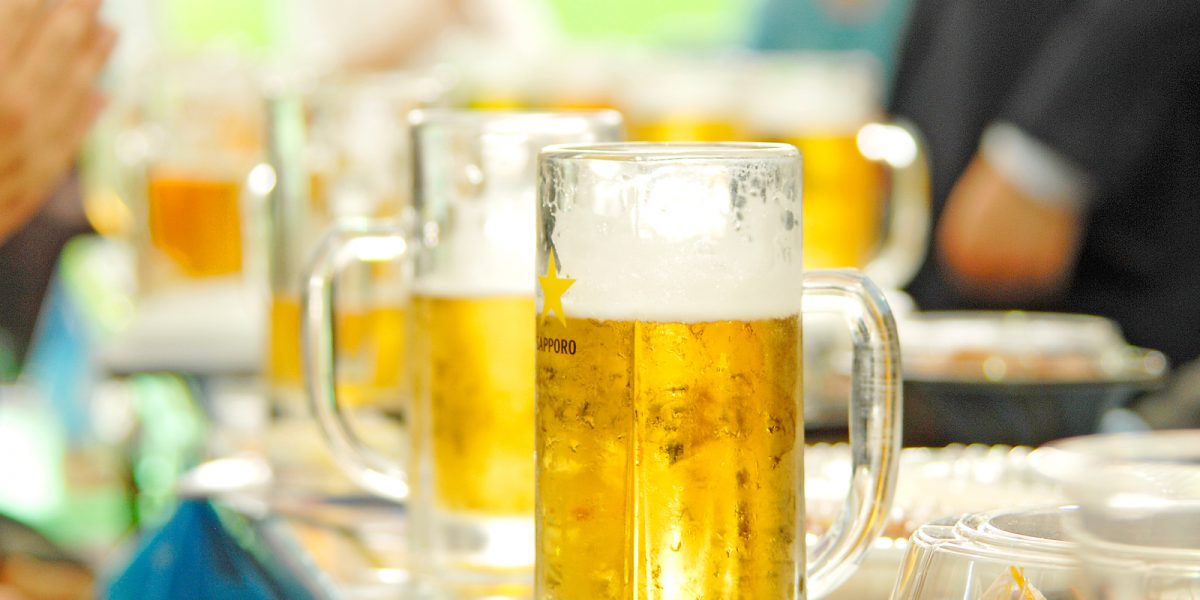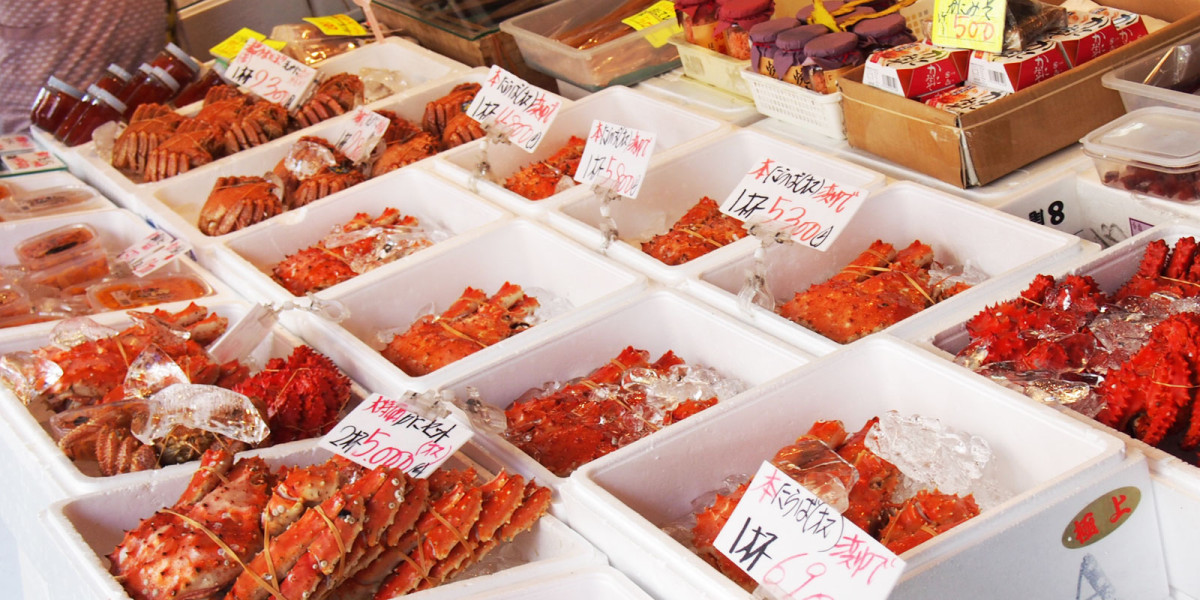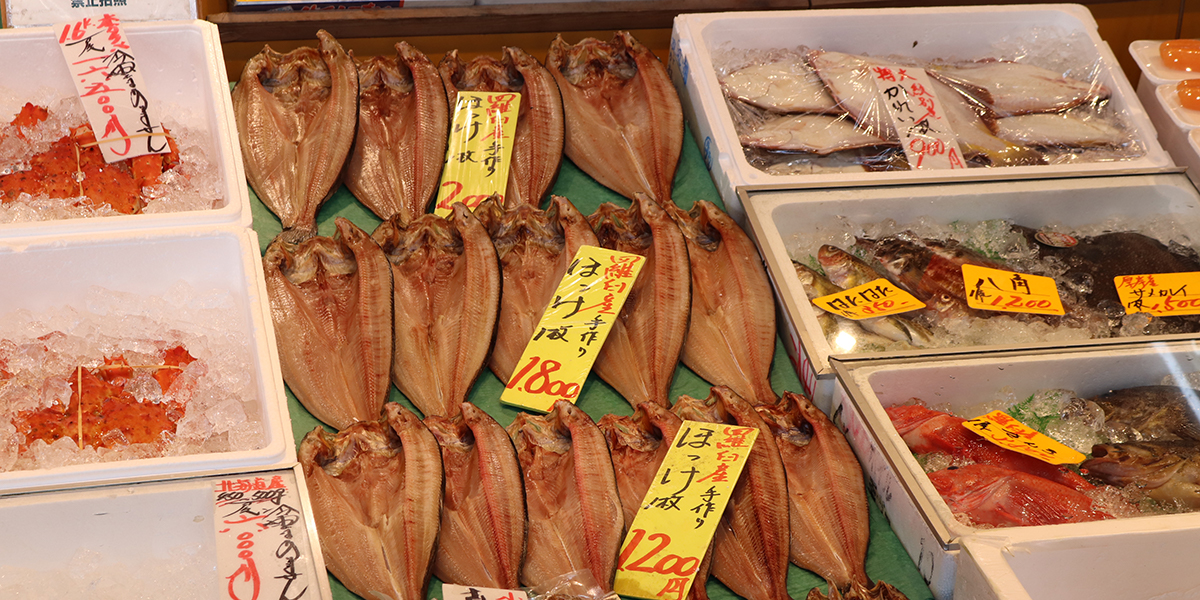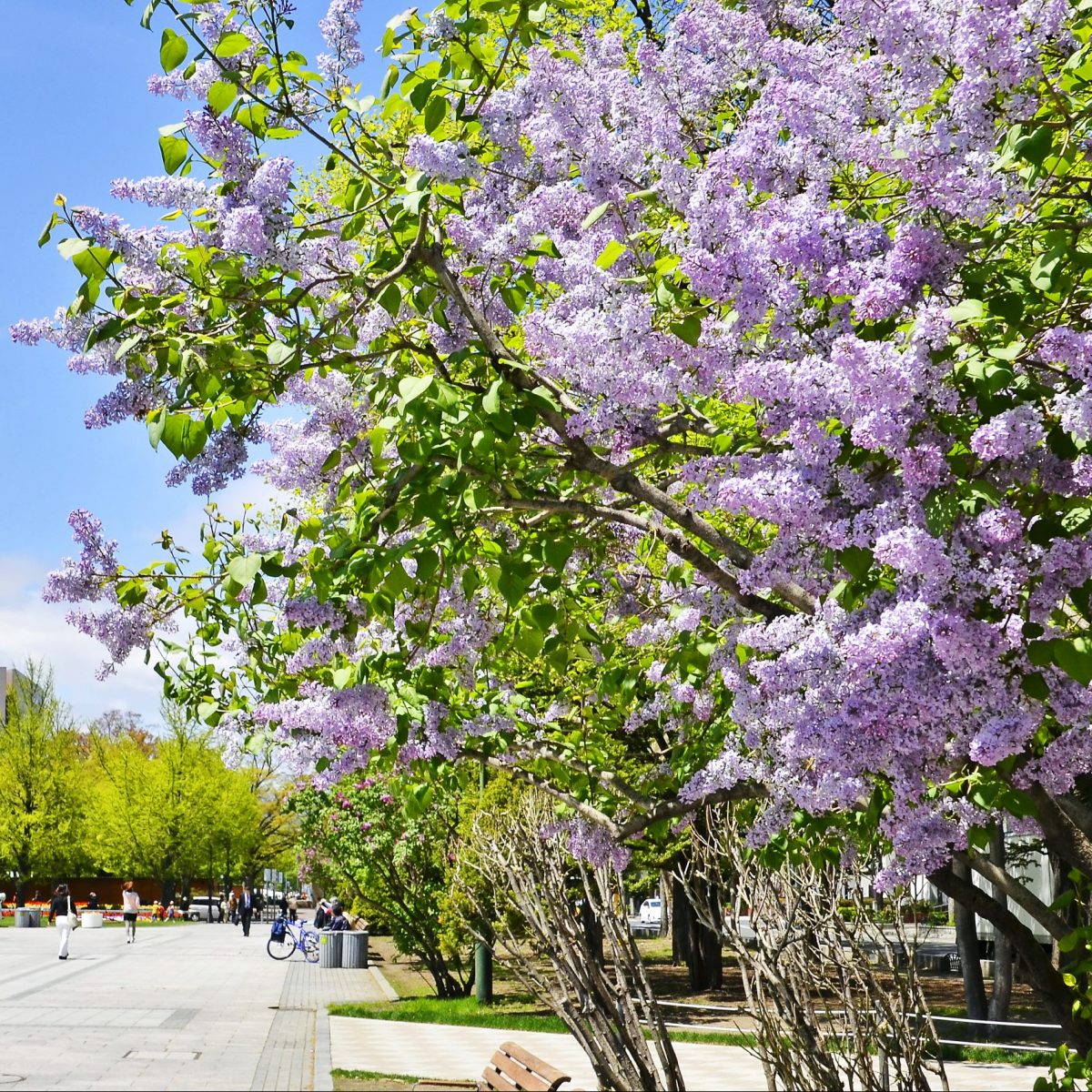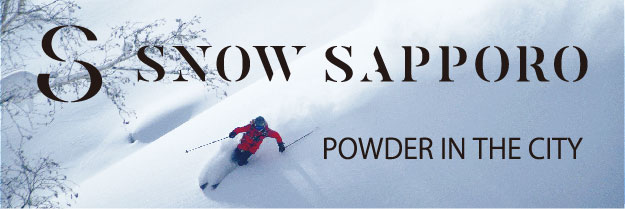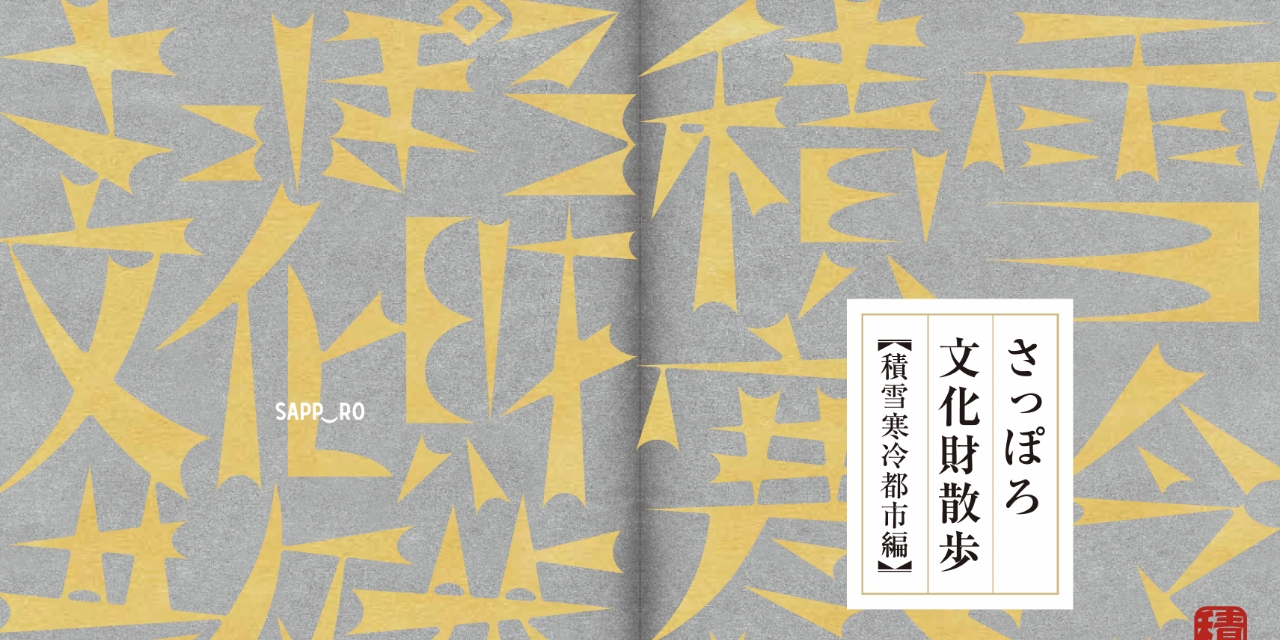
A Story Behind the Snowy, Cold City
A Life with Snow and Ice
ー Overcome, Utilize,
and Enjoy the Harsh Winters ー
In Sapporo, the lowest daily temperature falls below freezing for about one-third of the year, and snowfall is about 5 meters per winter. There are not many cities in the world that get so much snow and yet grow into a major metropolis. Our ancestors overcame, utilized, and enjoyed this severe weather and snow with various kinds of wisdom. The unique customs and culture developed in winter life are our historical heritage, passed down through generations.
Traditional Japanese-Style Houses Faced Difficulties
Technologies for building houses to comfortably live through Hokkaido’s harsh winters, such as home insulation, efficient heating, and roofs suitable for snow, continue to evolve.
The Ainu people’s houses, called chise, were built with wisdom and ingenuity to stay warm. For example, they were designed so that the heat from the hearth would accumulate on the ground. On the other hand, Wajin initially found it difficult to break away from traditional Japanese-style houses, which were suited to hot and humid climates. It is easy to imagine that the shabby thatched huts built by the first settlers must have been quite cold, but the Japanese houses that were built later on were also cold, and there are many tales of hardships, such as the collar of the bedding being frozen by breathing.
Although the Tondenhei, military settlers, were provided with housing from the beginning and did not have to build their own houses, the early houses they lived in were still Japanese-style.
-

Settler’s Thatched Hut
Owned by Hokkaido Museum
Trial and Error and the Development of Housing for Comfortable Living in Cold Climates
The Hokkaido Development Commision’s (Kaitakushi) mission was to assist the immigrants and develop the economy and industry. Improving the houses to withstand the cold was an urgent task.
In 1878, Kiyotaka Kuroda, the governor of Kaitakushi, visited
Russia and found their log cabins and pechkas to have excellent cold
resistance. He then built government buildings, schools, and
houses for Tondenhei in the Russian-style, and learned how to
make pechkas. However, the difficulty of obtaining materials and
the complexity of the structure prevented its widespread use.
Eventually, the American-style became the mainstream, as
represented by the Clock Tower and the Former Kaitakushi Main
Office Building.
However, when it came to residential buildings, Western-style
architecture did not fit the lifestyle of the Japanese, who take off
their shoes indoors. Therefore, around 1880, Takeshiro Nagayama,
the Secretary General of the Bureau of Tonden (later the Director
General of the Hokkaido Government), built a house that blended
Japanese and Western styles. It also influenced the design of
residential buildings built afterwards.
Brick and Sapporo Nanseki (soft stone) were used as building materials with heat-insulating and heat-storing properties, but they were expensive and used only for limited purposes, such as building warehouses. Instead of these, triangular-roofed concrete-block houses became widely popular after World War II. The groups of houses with steeply pitched triangular roofs, which snow easily slides off, were symbolic of Sapporo life. It also means that many people were finally free from the cold.
Today, high-performance insulation materials and construction methods have dramatically improved the insulation and airtightness of houses.Improvements in energy-efficient heating equipment are also advancing, making life in snowy cold regions more comfortable.
-

Former Nagayama Takeshiro Residence -

Concrete-block houses
Owned by Sapporo City Archives

Early Buildings Built to Cold-Weather Specifications Preserved in Historical Village of Hokkaido
The Historical Village of Hokkaido exhibits a variety of Meiji-era
houses, including Settler’s Thatched Huts, Tondenhei Barracks,
a relay station, and merchant houses. The Former Arishima
Residence is a Japanese-Western style house built in 1904 in
Shiroishi-mura, Sapporo County (present-day Shiroishi-ku,
Sapporo).
It presents the style of residential houses that were
beginning to be built at this time. Western-style designs such
as sashed windows were incorporated into the exterior, while
inside the house was conventional Japanese-style.
-

Former Arishima Residence (Historical Village of Hokkaido)
Snow Removal Tools That Have Evolved Uniquely in Hokkaido
In Hokkaido, where temperatures are low, snow is powdery, but when trodden down, it becomes solid ice and does not melt easily.
One of the traditional Japanese snow removal tools is called a kosuki. It is a shovel made of a single wooden board shaped like a boat oar. It was used for carving up and dumping heavy, wet snow. In Hokkaido, to efficiently scoop powdery snow, strips were added on three sides of the wooden board. Eventually, many useful tools were created, such as snow pushers (dumps) to push large amounts of snow, tools to throw snow farther with less power, and tools to break solid ice safely. In our daily lives, these tools continue to be improved.
Transportation is essential to people’s lives. Protecting it from snow has long been a challenge for governments and transportation operators. As a countermeasure against snow, a metal shelter was adopted to completely cover the entire track in the above-ground section of the Namboku Subway Line. Sapporo also has Sasara rotary-broom snow remover, which powerfully blast snow off the tracks and helps the streetcars operate in winter. It is renowned as a symbol of winter in Sapporo. Sasara is a broom made of a bundle of bamboo strips. The broom is highly elastic and, when rotated, can blow snow away without damaging rails. It has been used in Sapporo since the Taisho era (1912-1926). Thanks to this, the streetcars are often in operation, even on days when buses are not due to heavy snowfall, giving citizens great confidence in the streetcars. The Train Bureau is currently developing a permanent facility tour course.
-

Historical snow removal tools -

Sasara rotary-broom snow remover
The Technology to Use Snow as Resources
Moerenuma Park was designed by famous sculptor Isamu Noguchi. The inside of its symbol, the glass pyramid HIDAMARI, becomes very hot in the summer, like a greenhouse. Its air conditioning system uses the snow stored in the winter and keeps the place at a comfortable temperature in the summer.
Every year in March, the snow piled up in the park is carried into a special snow storage facility. The snow melts and becomes cool water, which is then circulated through a heat exchanger to distribute cool air to each room. The hot air in the rooms returns through the heat exchanger, warming water that melts more snow in the storage, regenerating cold water.
In order to cool water in a normal cooling system, heat sources such as electricity or gas are essential, which inevitably produce CO2. On the other hand, this snow air conditioning system uses cold water from melting snow, so it does not require a heat source and does not generate CO2.
A Toshin-Kita Snow-Melting Tank has been installed under the Sapporo-Eki Kitaguchi Plaza. The temperature inside the snow-melting tank is maintained at around 40°C to melt the snow, using hot water from the regional air-conditioning plants.
By dumping snow in the city center, the distance and time required for snow removal trucks to travel can be greatly reduced. Smooth snow removal results in a quick clearing of the roads, avoiding traffic congestion. The snow melted by the hot water is washed directly into the sewage system after the sediment is removed. In snow-free seasons, when snow melting is not required, it is also effectively used as a fire prevention tank.
The snow used to be something that had to be thrown away. Using this snow utilization technology, it can now be utilized as a natural energy source and reduce CO2 emissions. This is the future of snowy and cold regions.
-

Glass Pyramid in Moerenuma Park -

Toshin-Kita Snow-Melting Tank
Owned by Sapporo City Archives
With the Spirit of Enjoying the Snow and Cold
You may wake up in the morning, open the curtains, and find that the landscape outside your window has turned completely white. Snow that fell overnight covers the colors of the roofs and the asphalt of the roads that were visible just the day before. The clear air makes the sky look deep blue. You never get tired of the scenery where everything sparkles and shines. Although shoveling snow is tiresome, snowy landscapes have the power to make people smile the moment they see them.
Spending such a long period of time surrounded by so much snow, there is no way not to enjoy it. Children in Sapporo are creative when playing in the snow, building snowmen, sledding, and digging caves to build secret bases.
Many adults also enjoy winter fashion, winter camping, jumping out of saunas and into the snow, and making and lighting snow candles on their doorsteps. It is perhaps the wisdom of life to try to enjoy winter.
Sapporo Snow Festival, which was first held in 1950, has become an event widely known both in Japan and abroad. In 1981, another winter event, Sapporo White Illumination was started, modeled after the Rockefeller Center Christmas tree in New York City, U.S.A. These winter events in Odori Park entertain not only the citizens of Sapporo but also many visitors.
The harsh cold of winter is the reason for the great joy of a warm spring. This is one of the blessings that life in the North gives us.
-

Sapporo Snow Festival (Susukino Site)

Ice Carnival in Nakajima Park, a Fun Event for Citizens
The Sapporo Skating Association held annual skating festivals at the pond in Nakajima Park from 1925 with the aim of changing the lifestyle in winter, when citizens tended to stay indoors due to the cold weather. In a venue lit by countless light bulbs, people dressed up in costumes and performed elaborate runs to music played over the speakers. Before World War II, it was a winter tradition similar to the Snow Festival today.
-

Ice Carnival Owned by Sapporo City Archives
Sapporo’s Food Culture Nurtured by the Cold Weather
The media often mentions that, in Hokkaido, people keep their rooms warm in winter, wear a T-shirt, and eat ice cream. In fact, the inside of a highly airtight house can be very warm due to heating, so having ice cream or a cold beer makes perfect sense. It is unlike winters in other places such as Tokyo, where people wear heavy clothes and get into a kotatsu (a table with heating), leaving their backs to shiver in the cold air. On the other hand, ramen tastes exceptional when you are freezing cold from walking around in the subzero temperatures in the city. Miso ramen, in particular, is especially appreciated in winter because the layer of oil on the surface of the soup keeps ramen nice and hot.
In Sapporo, research and experimentation in agriculture to take advantage of the cold climate has also been conducted since the early Meiji period (1868-1912). In 1876, Edwin Dun was transferred to Sapporo as a foreign technical specialist hired by Kaitakushi (the Hokkaido Development Commission). He established a dairy farm in Makomanai, teaching dairy and livestock farming and production of dairy products (butter, cheese, and condensed milk). This became the foundation for the development of dairy and livestock farming in Hokkaido.
Sapporo-Taikyu, a giant cabbage, is a traditional vegetable in Sapporo. It can be preserved under the snow and is a valuable source of vitamins in winter. And what’s more, this cabbage and the chilly weather of Hokkaido are what makes for a delicious Nishin-zuke (traditional pickles using cabbage and herring).
-

Edwin Dun Memorial Museum -

“Sapporo-Taikyu” Cabbage

Snowy Mt. Moiwa Appeared in the Lyrics of “Tetsudo Shoka” (Songs of Railways)
“Tetsudo Shoka” (Songs of Railways) is a long song written by
Takeki Owada, a scholar of Japanese literature. In fact, there
is also a Hokkaido version, “Hokkaido Shoka Kita-no-Maki”(Songs
of Hokkaido) published in 1906, in which the four seasons of
Sapporo are described.
Mt. Moiwa on a snowy morning appears as a symbol of winter
scenery. With wet snow piling up on the branches, the trees seem
like they blossomed. The beauty remains the same today.
-

Mt. Moiwa in the snow
Winter Sports for Casual Recreation
Sapporo hosted the 1972 Winter Olympics. Winter sports have always
been familiar to people in Sapporo.
Skating was first introduced to Japan in 1877. It is said that
William Brooks, a teacher at Sapporo Agricultural School (later
Hokkaido University), first showed his students how to skate on
the skating boots he had brought from the United States.
Eventually, skating became popular among the local people. They
ordered expensive import skates or asked local blacksmiths to
make similar ones. It is said that they skated in
Nakajima Park and the front yard of the Hokkaido Government
Office.
On the other hand, skiing was introduced to Sapporo in 1908. It is said that Hans Koller, a teacher at the College of Agriculture, Tohoku Imperial University, which had been promoted from Sapporo Agricultural School the previous year, imported tools from his home country and introduced them to his students. The students went up to Mt. Sankakuyama, made a ramp on the slope to jump, and enjoyed skiing. In addition, a number of mountain lodges were built to serve as bases for traversing the mountains. Imperial Prince Chichibunomiya’s visit in Hokkaido in 1928 and the International Miyasama Ski Games that followed made skiing, as well as skating, a sport that local people enjoy as a casual recreational activity.
Today, skiing is a familiar part of the people’s lives, as it is taught in classes at elementary schools in Sapporo. Sapporo is an exceptional metropolis that has both the climate and location that are ideal for skiing and snowboarding. Here, you can enjoy night skiing in the floodlights after work. Sapporo has a variety of ski resorts in the city, both large and small. Sapporo Moiwa Ski Area is conveniently located near the city center, Sapporo Bankei Ski Area offers a snowboard park, and Sapporo Kokusai Ski Area is close to the hot spring resort area and offers abundant snow until the Golden Week holiday season.
Mt. Sankakuyama is the birthplace of skiing in Sapporo, and Miyanomori is the home of the International Miyasama Ski Games. Neither of these places have ski resorts today, but Okura, Miyanomori, and Araiyama ski jump grounds are located in the nearby mountains. Sapporo hosts numerous ski competitions every year, from junior competitions to international ones. The opportunity to watch some of the world’s highest-level competitions is one of the attractions of Sapporo, the winter sports city.
-

Sapporo Mt. Moiwa Ski Resort
The Cultural Assets Related to the Stories
| Name of the cultural asset | State of the designation | Location |
|---|---|---|
| Cise | Not designated | Koganeyu 27, Minami-ku (Sapporo AINU Culture Promotion Center) |
| Settler’s Thatched Hut | Not designated | Atsubetsucho Konopporo 50-1, Atsubetsu-ku (Historical village of Hokkaido) |
| Former Nagayama Takeshiro Residence | Hokkaido Designated Tangible Cultural Property | Kita 2-jo, Higashi 6-chome, 2, Chuo-ku |
| Triangular-roofed concrete-block houses | Not designated | Kiyota, Tonden, and other places |
| Former Arishima Residence | Not designated | Atsubetsucho Konopporo 50-1, Atsubetsu-ku (Historical village of Hokkaido) |
| Historical snow removal tools | Not designated | Nishimachi Minami 21-chome, 3-10, Nishi-ku (Teine Memorial Museum) and other facilities |
| the Shelter of Sapporo Subway Namboku Line | Not designated | Between Minamihiragishi and Makomanai Subway Stations |
| “Sasara” rotary-broom snow remover | Sapporo Furusato Culture 100 Selections | Minami 21-jo Nishi 16-chome 2-20, Chuo-ku (The train bureau) |
| Moerenuma Park | Not designated | Moerenuma Koen 1-1, Higashi-ku |
| Toshin-Kita Snow-Melting Tank | Not designated | Kita 7-jo Nishi 3-chome, Kita-ku |
| Sapporo Snow Festival | Not designated | Odori Nishi 1-chome to 12-chome, Chuo-ku |
| Odori Park | Sapporo Furusato Culture 100 Selections | Odori Nishi 1-chome to 12-chome, Chuo-ku |
| Nakajima Park | Sapporo Furusato Culture 100 Selections | Nakajimakoen, Chuo-ku |
| Edwin Dun Memorial Museum | Registered Tangible Cultural Property | Makomanai Izumimachi 1-chome, 6-1, Minami-ku |
| “Sapporo-Taikyu” Cabbage | Not designated | Kita 1-jo Higashi 4-chome, 8-8, Chuo-ku (Sapporo Taikyu Oentai Office) |
| Introduction of skiing and skating | Sapporo Furusato Culture 100 Selections | Miyanomori 1274, Chuo-ku (Sapporo Olympic Museum) |
| Sapporo Mt. Moiwa Ski Resort | Not designated | Moiwashita 1991, Minami-ku |
| Sapporo Bankei Ski Area | Not designated | Bankei 410, Chuo-ku |
| Sapporo Kokusai Ski Resort | Not designated | Jozankei 937, Minami-ku |
| Mt. Sankakuyama | Not designated | Yamanote, Nishi-ku |
| Okura-Schanze | Sapporo Furusato Culture 100 Selections | Miyanomori 1274, Chuo-ku |
| Miyanomori Ski Jump Stadium | Not designated | Miyanomori 1-jo 18-chome, Chuo-ku |
| Araiyama-Schanze | Not designated | Miyanomori 902, Chuo-ku |
| Mt. Moiwa Primeval Forest | Nationally Designated Natural Monument | Mt. Moiwa, Sapporo |
*Some of the above lists are not open to the public.
Let’s Visit the Cultural
Assets Related to the Stories!
-

Triangular-roofed concrete-block houses
(Tonden Danchi)This housing complex was built in 1970, during Japan’s period of rapid economic growth. It features over 800 houses built over the vast land. The houses have distinctive triangular roofs, designed to withstand heavy snowfall, and exteriors made of concrete blocks.
-

Moerenuma Park
The park was designed by world-renowned sculptor Isamu Noguchi, who envisioned the entire facility as a single work of art.
-

Historical snow removal tools
Traditional snow removal tools were mainly made of wood and bamboo and often crafted by hand to fit the user’s body shape. Various improvements were made over time so that snow could be cleared better.
-

Former Nagayama Takeshiro Residence
Built in the early Meiji era (1868-1912) as the private residence of Takeshiro Nagayama, the second governor of Hokkaido, this house is a pioneer example of an upper-class residence that combines Japanese and Western architectural styles.
-

Introduction of skiing and skating
Skiing, which originated in Scandinavia, was introduced to Japan during the Meiji era (1868-1912) and eventually made its way to Sapporo. In addition, it is said that Sapporo was the first place in Japan where skating was practiced.
-

Okura-Schanze
Opened in 1932, the complex was renovated for the Sapporo Olympics and renamed to become the Okurayama Ski Jump Stadium. It is also popular as a tourist destination for its beautiful panoramic views of the city.
-

Araiyama-Schanze
This ski jump facility is the oldest and the only one still in existence in Sapporo City. There are two jumps, a medium hill and a small hill, which are used by elementary and junior high school students.
-

Nakajima Park
Located near the heart of the city, Nakajima Park is a place of relaxation. Nestled under long lines of sakura trees surrounding a large pond and open grass, it has been selected as one of the 100 Best Urban Parks in Japan.
-

Former Arishima Residence
This historic building is where Takeo Arishima, one of the leading authors of modern Japanese literature, lived for about a year from 1910. It is an iconic piece of architecture from the time when Western-style designs were just starting to become adopted.
-

Miyanomori Ski Jump Stadium
A normal hill facility was built together with the Okurayama Ski Jump Stadium. The Sapporo Mayor’s Cup Summer Jumping Competition and other events are held here.
-

Sapporo Bankei Ski Area
Within 20 minutes by car from central Sapporo, there are a variety of 17 courses. For those playing until 9pm, the evening lights offer a sparkling panoramic view of the city.
-

“Sasara” rotary-broom snow remover
“Sasara” is a type of hard bamboo brush. One of the traditional winter sights in Hokkaido is watching one of the utiliity streetcars, attached with a set of rotating Sasara, cleaning the tracks of heavy snow.
-

Mt. Moiwa Primeval Forest
A part of Mount Moiwa (elevation 531m), located near the center of Sapporo City.This primeval forest is a valuable academic resource because it is home to rare forest flora.
-

Sapporo Mt. Moiwa Ski Resort
Night skiing, overlooking Sapporo City, is always popular. The ski hill features 10 courses but unfortunately prohibits snowboarding at this time.
-

Edwin Dun Memorial Museum
Dan was one of the foreign instructors invited by the Hokkaido Development Commission. The museum houses a large collection of photographs of Makomanai taken from around 1972.
-

Sapporo Kokusai Ski Resort
The resort boasts some of the best powder snow and snowfall in Hokkaido. There is also a 3.6 km long cruising run that can be enjoyed by skiers of all levels, from beginners to advanced.
Check out All the Cultural Properties
in the Story!
-

Cafe gakeno-ue
If you’re looking for a peaceful place to relax, look no further than this hidden cafe in the forest near the hot spring town of Jozankei. The cafe has only 10 seats and is located on a cliff about 40 meters high, offering stunning views of Jozankei and the surrounding wildlife.
Jozankei 567-36, Minami-ku, Sapporo
-

Gelato&Bake WHITE
Feel like a treat that is delicious and refreshing? Look no further than Gelato & Bake White! They offer a wide variety of Italian gelato flavors, all made with Hokkaido milk. They also have the popular “Dora Pan” sandwich, which is made with their signature cream and fresh pancakes from their sister store. On a clear day, you can enjoy your sweets while looking out at Mt. Moiwa from the terrace.
Minami 19-jo Nishi 16-chome 7-7, Chuo-ku, Sapporo
-

Sandria
This popular sandwich shop, which first opened in 1978, only offers takeout service but is open 24 hours a day and has a selection of over 40 kinds of delicious varieties on the menu.
Minami 8-jo Nishi 9-chome 758-14, Chuo-ku, Sapporo
-

Shiroi Koibito Park
This sweets theme park offers visitors a fun tour, showcasing the production process of the famed Shiroi Koibito cookie, as well as the chance to enjoy making sweets too!
Miyanosawa 2-jo 2-chome 11-36, Nishi-ku, Sapporo
-

Oni wa Soto, Fuku wa Uchi!
By day, indulge in the restaurant’s signature curry udon. As evening descends, savor the luxurious A4 and A5 grade Hokkaido black wagyu beef, prepared sukiyaki (grilled) or shabu-shabu (hotpot) style, while the glittering cityscape of Sapporo unfolds before you. This cozy haven even boasts a serene stone garden within.
Fushimi 1-chome 3-11, Chuo-ku, Sapporo
-

Miyanomori Frances Church
A marvel of relocation, this church was rebuilt in 1995 from an actual 1800s cathedral brought in to Sapporo from southern France, preserving its historic beauty.
Miyanomori 3-jo 10-chome 3-25, Chuo-ku, Sapporo
-

Sapporo Teine
Home of the 1972 Winter Olympics, Teine Mountain Ski Resort, which sits at an altitude over 1000 meters, boasts 15 diverse runs and welcomes skiers of all levels.
Teine Honcho 593, Teine-ku, Sapporo
-

Makomanai Park
This popoular historic rink is open to the public for a small fee during the winter season. The park also has a 3km course, perfect for skiing or just taking a relaxing walk through the soft powder snow.
Makomanai Park 3-1, Minami-ku, Sapporo
-

Shinrin Park Spa Kiyora
Immerse yourself in the exquisite luxury of a rare Mohr hot spring, a hidden treasure found only in southwest Germany and a secluded nook of Hokkaido. Let its mineral-rich waters, warmed by the earth’s embrace, thaw your winter-kissed body and melt away your cares.
Atsubetsu Higashi 4-jo 7-chome 1-1,Atsubetsu-ku, Sapporo
-

Kuni Sushi
Whispering of good times since 1974, this local gem serves both lunch and dinner at wallet-friendly prices, earning the loyalty of discerning regulars.
Kokune BLD3F, Kita 1-jo Nishi 3-cyo-me, chuo-ku, Sapporo
-

Nopporo Forest Park
Nestled across Sapporo, Ebetsu, and Kitahiroshima, this 2,053-hectare prefectural park offers verdant escape. With 80% protected national forest and a vibrant bird sanctuary, it’s a treasure trove of nature and serene forests.
Bunkyo714, Ebetsu
-

Cafe Nagayama Rest
Step back in time at this photogenic cafe, nestled within the historic walls of the Nagayama Takejiro Residence and Mitsubishi Mining Dormitory. Savor nostalgic Western fare and decadent parfaits amidst a unique blend of architectural styles.
Kita 2-jo Higashi 6-2, Chuo-ku, Sapporo
-

Nouvelle Pousse Okurayama
Nouvel Pousses, “new shoots” in French, sprouts a culinary revolution. The chef champions Mebuki, a unique fusion where French roots intertwine with Japanese whispers, challenging tradition with every innovative plate.
Sapporo Olympic Museau Annex 2F, Miyanomori 1274, Chuo-ku, Sapporo
-

Sapporo City Sewage Science Museum
From flush to future: This science museum takes families on an educational journey through the essential world of sewers, showcasing infrastructures and technologies, as well as revealing their impact on our environment and sparking a sense of responsibility.
Asabu-machi 8-chome 1, Kita-ku, Sapporo
-

Dekamori Kaisen (Shinkotoni Main Branch)
Weighing in at a whopping 1kg, their signature seafood rice bowl is a showstopper. Packed with fresh seafood delights, it’s no surprise this delivery/takeout shop has a large following of loyal fans.
Shinkotoni 7-jo 2-chome 2-31, Kita-ku, Sapporo
- Publishing
-
Sapporo City Council for the Promotion of Historical and Cultural
Town Development
(The secretariat: Cultural Properties Division, Culture Department, Citizen’s Cultural Bureau, Sapporo City) - 10F Sapporo Clock Tower Building 2-chōme-1 Kita 1 Jōnishi, Chuo Ward, Sapporo,
- TEL 011-211-2312
- March 2023


